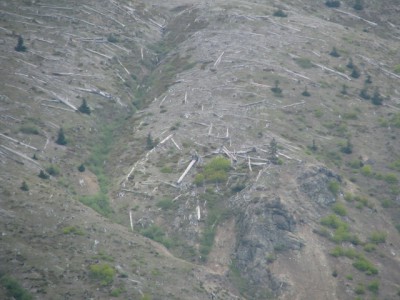Let’s face it – Jon’s schedule sucks. While I am an 8 to 5’er, with weekends and holidays off, Jon has an extremely unpredictable schedule. He works an endlessly flip-flopping schedule of days, afternoons and evenings, with the occasional two or three week stint of graveyard shifts. He gets one weekend off per month, and he is supposed to get one other Sunday off each month (but he usually doesn’t). The only predictable part of Jon’s schedule is the fact that I typically have no idea when he is working the next week, or even the next day.
One weekend off per month, and one Sunday. Let that sink in… That means, that unless we are on vacation, Jon and I get a maximum of three days off together each month. That sucks…
Earlier this summer, Jon did get a Sunday off, and we took the opportunity to do a local hike to Oyster Dome. There are two different starting points for the trail, depending on if you want to take the long, hard way, or the short, hard way. We did the long one.
The trail starts out with a series of switchbacks, with steep sections and not so steep sections. But there are enough switchbacks in the woods that you begin to wonder if they will ever end. The answer is no – I really believe that they just continue on forever. There are a few places along the way where you are greeted with beautiful views of Bellingham Bay, the San Juan Islands, and the Skagit Tide Flats. Stunning!
The day that we were there, it was threatening to rain, which made for an extremely humid day. The humidity enveloped the woods in an ethereal mist that was really beautiful to see, but difficult to capture in photos. The cloud cover also meant that parts of the woods were fairly dark, giving it a foreboding horror movie feeling.
The switchbacks eventually end, and we hiked quietly through the woods for awhile, over a few small creeks and boggy areas, until we were greeted with a scramble straight up the hill over tree roots and loose rocks. It is the hardy hiker that doesn’t resort to grabbing a tree branch here or there to steady himself.
Then comes more wandering through the woods, past huge, old chains that once helped loggers haul gigantic trees out of these woods. When logging operations ceased, they just left some of the bigger equipment there. We also saw the old marks on tree stumps made by the springboards; loggers would make notches in the trees to insert boards to stand on. This allowed them to cut high enough where the tree was narrower and the saw could fit around it. Of course, this left stumps between 6 and 10 feet tall that are still standing today.
When you finally get to the top of Oyster Dome (I have no idea why it is called that), you come out of the woods to stand on a huge, bare rock overlooking the Bay and the Tide Flats. The view is beautiful and peaceful. This is always where I realize that the grueling hike was worth it.
The hike back down is the same trail – so it is the same steep, tree root and rock scramble in reverse, and then we hiked down the never-ending switchbacks to the bottom. By the time we reached the road, my legs were jelly and I swear I used muscles I never knew I had. I was soaked in sweat, but I was proud of my accomplishment. This is one of my favorite hikes at home; it is beautiful and a great workout!
Note: The entire hike is 6 miles roundtrip and is listed in the hiking books as strenuous. But if you decide to do it, the views are spectacular!




















